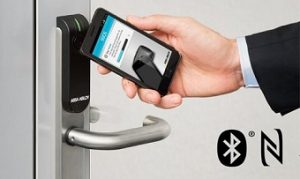
Mobile access is changing the way we interact with buildings and how we manage their security. The smartphone becomes a mobile key just as easily as it transforms into a payment card or a map. The device which users already carry enables them to unlock buildings or rooms, across one or multiple sites, securely and at a lower cost to the business than alternative credentials.
According to one recent access control market report, users often view the benefits as a powerful triad of convenience, cost and security. The security of a mobile credential offers enhancements over a smart-card or fob, because biometrics are built into almost every modern smartphone via fingerprint or face ID unlocking.
Human behaviour is also on the side of the smartphone. How quickly would a student or employee notice a missing plastic access card? Everyone is more careful with their handset. Facilities staff are left frustrated when users lend or share credentials. Far fewer users are willing to pass on their phone, even for 5 minutes.
Following a recent survey, Assa Abloy found that around two-thirds of organisations plan to adopt mobile access control within two years, or already have. And, according to an Omdia report, mobile credential downloads grew by 220% between 2018 and 2019. This growth path is likely to continue. From a security management point of view, enhanced convenience is the major driver.
Mobile credentials can be amended over the air, without any need for dedicated updaters or asking a user to check-in their credential. Nobody is left waiting around for access permissions to update. Furthermore, when a security administrator cancels a mobile key, it vanishes immediately from a user’s phone. No more time-wasting handover meetings are scheduled when a tenancy, employment contract or authorised visit ends.
Cost efficiencies also accrue by switching away from plastic credentials: Mobile keys remove any need to source and print smart-cards, badges or fobs.
All these advantages are available in a building equipped with Aperio battery powered locks from Assa Abloy. Aperio mobile access is built on Seos, a next-generation platform with innovative cryptography and authentication, plus effective privacy protection. Unlocking an Aperio device is easy and intuitive: users simply present their phone at the reader, just as they would a smart-card. They don’t even need to open an app.
Aperio locks are compatible with all major RFID credentials, as well as with Bluetooth and NFC mobile wireless protocols, too. User experience at the door is identical for each. No training is needed.
These locks can operate with all credential technologies simultaneously: Building users need not stick unanimously to one format. Security managers do not have to implement a mass transfer to a single technology. Because Aperio is built for maximum compatibility, businesses can run RFID and mobile in parallel. They can upgrade from low- to high-security credentials when they choose. Every technology is always included in the package: There is no decision to make at the moment of purchase.











